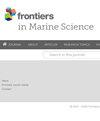Studying the temporal bias of the steady-state approximation of 234Th-derived carbon export during phytoplankton blooms
IF 2.8
2区 生物学
Q1 MARINE & FRESHWATER BIOLOGY
引用次数: 0
Abstract
The研究浮游植物繁殖期间 234Th 碳输出稳态近似值的时间偏差
234Th-238U对技术广泛用于估算颗粒有机碳(POC)通量,通常采用稳态(SS)假设。由于忽略234年的时间变化,ss推导的POC通量与实际的POC通量之间往往存在时间偏差。然而,由于缺乏234号剖面和沉积物圈闭的连续采样,这种时间偏差尚未得到充分研究。本文在物理-生物地球化学模型的基础上建立了234的放射性痕量模型,模拟了东南亚时间序列(SEATS)站点POC沉降过程对水柱中234的清除作用。该模式模拟的234条剖面的季节特征与现场观测结果基本吻合。基于模型模拟的分析表明,时间偏差可以用简化的234连续方程来描述和再现。通过对简化后的234方程进行解析,得到了SS-derived POC通量的解析解,发现时间偏差是由SS-derived和直接下沉POC通量之间的时间相位差引起的。为了提供一种不需要重复采样的方法来减少现场观测的时间偏差,我们为解析解中ss导出的POC通量构建了一个修正项。将这一项应用到百慕大大西洋时间序列和seat获得的数据中,偏差分别减少了67%和34%。在SS假设下,本研究提供了一种可行的方法来提高234导得的POC通量。
本文章由计算机程序翻译,如有差异,请以英文原文为准。
求助全文
约1分钟内获得全文
求助全文
来源期刊

Frontiers in Marine Science
Agricultural and Biological Sciences-Aquatic Science
CiteScore
5.10
自引率
16.20%
发文量
2443
审稿时长
14 weeks
期刊介绍:
Frontiers in Marine Science publishes rigorously peer-reviewed research that advances our understanding of all aspects of the environment, biology, ecosystem functioning and human interactions with the oceans. Field Chief Editor Carlos M. Duarte at King Abdullah University of Science and Technology Thuwal is supported by an outstanding Editorial Board of international researchers. This multidisciplinary open-access journal is at the forefront of disseminating and communicating scientific knowledge and impactful discoveries to researchers, academics, policy makers and the public worldwide.
With the human population predicted to reach 9 billion people by 2050, it is clear that traditional land resources will not suffice to meet the demand for food or energy, required to support high-quality livelihoods. As a result, the oceans are emerging as a source of untapped assets, with new innovative industries, such as aquaculture, marine biotechnology, marine energy and deep-sea mining growing rapidly under a new era characterized by rapid growth of a blue, ocean-based economy. The sustainability of the blue economy is closely dependent on our knowledge about how to mitigate the impacts of the multiple pressures on the ocean ecosystem associated with the increased scale and diversification of industry operations in the ocean and global human pressures on the environment. Therefore, Frontiers in Marine Science particularly welcomes the communication of research outcomes addressing ocean-based solutions for the emerging challenges, including improved forecasting and observational capacities, understanding biodiversity and ecosystem problems, locally and globally, effective management strategies to maintain ocean health, and an improved capacity to sustainably derive resources from the oceans.
 求助内容:
求助内容: 应助结果提醒方式:
应助结果提醒方式:


